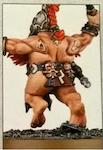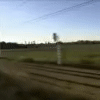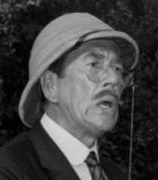|
4 days old http://www.demingheadlight.com/story/news/2017/05/30/union-pacific-train-derails-west-deming/102329332/
|
|
|
|

|
| # ? May 10, 2024 04:38 |
|
https://www.youtube.com/watch?v=GcDNNeMO-lw
|
|
|
|
https://www.youtube.com/watch?v=H6O90gIdUzg&t=112s I wonder who that sign is directed towards. The frothers or just a warning on probably loading.
|
|
|
|
It's both actually - don't give this car a shove on a downhill and let its momentum and the track brakes in the hump yard do your coupling for you, and do not try to couple yourself with the car. https://www.youtube.com/watch?v=zlSM_Tyfmts&t=68s Example of a hump yard. IPCRESS fucked around with this message at 01:44 on Jun 5, 2017 |
|
|
|
From the BLE-Tquote:Today, BNSF advised us that they intend to begin auditing inward/outward facing camera footage beginning May 29, 2017. Both BLET and SMART-TD are on record as opposing the use of these cameras for operational testing. We believe this is a very bad idea.
|
|
|
|
Anyone else in Melbourne seen the new PTV poster ads unsubtely goatse'ing people?  . .
|
|
|
|
Talk about having a suck day: a guy got hit by both a UP train and an Amtrak train. Apparently still alive. http://www.oregonlive.com/portland/index.ssf/2017/06/man_hit_by_2_trains_in_se_port_1.html
|
|
|
|
https://www.washingtonpost.com/news...m=.47a04dc4553a 2 csx conductors struck and killed by amtrak on the nec. should have known better.
|
|
|
|
|
Well I guess Hunter Harrison balled up and threw away most of the safety/safety programs there when he took office/ Any CSX guys on here who can confirm/deny?
|
|
|
|
New derailment alert with a chance of ecological disaster. http://chicago.suntimes.com/news/freight-train-derails-near-plainfield/ Also, thanks for the 'Crap British trains' posts Axeman Jim and the other users' similarly styled contributions.
|
|
|
|
Subways are in bad shape all over it seems. http://newyork.cbslocal.com/2017/07/06/penn-station-derailment/ Posted this in the crappy construction thread awhile back. https://www.nytimes.com/2017/06/29/nyregion/cuomo-declares-a-state-of-emergency-for-the-subway.html
|
|
|
|
Major derailment in Milwaukee: http://www.tmj4.com/news/local-news/train-derails-above-busy-west-allis-street Greenfield Ave is a major street in the area, for what it's worth.
|
|
|
|
iospace posted:Major derailment in Milwaukee: http://www.tmj4.com/news/local-news/train-derails-above-busy-west-allis-street "We have trains go through here all the time yah know..." Before watching the video, all I could think of was Fargo.
|
|
|
|
Lime Tonics posted:Subways are in bad shape all over it seems. Doesn't a lot of the NYC Subway infrastructure rely on craftsmen sourcing, rebuilding, and sometimes outright-manufacturing signalling parts from like the 1930's?
|
|
|
|
Boston's Green Line has signal equipment dating back to the 1890s
|
|
|
|
http://i.imgur.com/ZrIPAsG.mp4
|
|
|
|
THOMAS NO
|
|
|
|
Still a more pleasant journey than the Bakerloo line.
|
|
|
|
Terrible Robot posted:THOMAS NO Thomas gets Radicalized.
|
|
|
|
Hope you weren't planning to get a train ride this evening in Melbourne. I would not be at all surprised if VicTrack had a single point of failure for something important on their infrastructure network.
|
|
|
|
Neddy Seagoon posted:Hope you weren't planning to get a train ride this evening in Melbourne. Word is Telstra hosed up with the network links
|
|
|
|
Neddy Seagoon posted:Hope you weren't planning to get a train ride this evening in Melbourne. I haven't heard the exact cause yet, but disconnecting the primary control centre (Metrol) from the backup site (DRS) restored the system. The link is used to co-ordinate the control level variables of the systems, so it seems like something at the DRS went rogue and killed everything everywhere. Not the first time it's happened, and we've had a rogue switch take out a network before by loving with spanning tree
|
|
|
|
 
|
|
|
|
Yeah, somebody was not thinking on that one.
|
|
|
|
https://i.imgur.com/BzdSJsm.gifv
|
|
|
|
Is it blowing unburnt coal dust out its stack? That doesn't seem safe.
|
|
|
|
hey Choo choo peeps. Keolis has an open position that runs right up my alley. Does anyone know anything/have an opinion of them as a company to work for? This would be IT stuff, not anything on the rails.
|
|
|
|
Gorilla Salad posted:Is it blowing unburnt coal dust out its stack? I suppose a combination of putting too much slack on at once, a strong draft (and that was going pretty fast to generate one), and not enough secondary air would enable a lot of un-burnt particles to come out of the chimney. They'd still be hot and exposed to the oxygen outside would allow them to ignite. Never seen much more than the odd cinder/spark come out myself, though. (I was going to go into some detail explaining stuff but didn't want to teach you all how to suck eggs - everyone here seems pretty knowledgeable.)
|
|
|
|
Clarence posted:(I was going to go into some detail explaining stuff but didn't want to teach you all how to suck eggs - everyone here seems pretty knowledgeable.) are you quite serious
|
|
|
|
Yeah i know a lot about IC engines and turbines and all of that but steam locomotives I only have the basics. An in depth explanation would be sweet if you're willing to give it.
|
|
|
|
I'll put together an effort post.
|
|
|
|
Basically, inside a steam locomotive you have a bunch of oarsmen turning handles. The smoke, ash and steam are all there to distract from the fact that they're nonunion. https://www.youtube.com/watch?v=8grHpQAB1jA for the source on the .gif above. IPCRESS fucked around with this message at 15:46 on Jul 20, 2017 |
|
|
|
Oh, it's China. I understand now.
|
|
|
|
wilfredmerriweathr posted:Yeah i know a lot about IC engines and turbines and all of that but steam locomotives I only have the basics. Honestly for some reason (autism spectrum disorders) the https://en.wikipedia.org/wiki/Steam_locomotive#Basic_form wikipedia page is pretty good!
|
|
|
|
Cocoa Crispies posted:Honestly for some reason (autism spectrum disorders) the https://en.wikipedia.org/wiki/Steam_locomotive#Basic_form wikipedia page is pretty good!
|
|
|
|
Delivery McGee posted:To oversimplify: works pretty much like a 2-stroke gas engine, except the rapidly-expanding gas that pushes on the piston is steam made by an external boiler instead of an explosion in the cylinder. Steamships' engines used the same principle as locomotives (but on a much larger scale) until around the end of WWII, when giant diesels became the norm. Steam turbine-powered ships (nuclear or oil-fired, though the first one was built in 1894, and coal-fired) are like a turboshaft but with steam instead of the compressor/burner stages. To be more accurate, from the late 19th century to the mid 20th, steam ships used triple expansion engines which send the steam through three different pistons to extract as much energy as possible from the steam. In 1906, the HMS Dreadnought was the first warship to use a steam turbine and instantly all piston powered warships were obsolete, triple expansion was almost exclusively used by civilian shipping. Also, all steam ships use condensing engines under vacuum for increased power and efficiency rather than discharging steam to the air like most locomotives.
|
|
|
|
Some basics of steam operation, with doubtless many tangents along the way. This has turned out to be much longer than expected, so it'll be just the burning of coal in a locomotive in this part and I'll cover steam itself later. This is from a UK perspective so some particulars will differ from elsewhere. I'm a qualified (practical and written exams and everything!) fireman at a UK preserved line, with experience of other lines. While I've no direct main line experience I've fired quite a few locomotives that have/are used for that. There will be no mention of automated feeding of coal etc as that's out of my experience. Brief list of locos I've experience on - Black 5s (I think it's four different ones now), Standard 5, S15 (Southern), B1, A4 (like Mallard), Q6, West Country, S&D 7F, Super D, Ivatt 2MT, GWR 56XX, 9F, K1, Standard 4 (both 2-6-0 and 4-6-0). I'll start with fires/raising steam then move on to how the steam is used. On the face of it raising steam is a doddle - bung coal through a hole onto a fire and steam is produced, but as with anything there are many subtleties involved. Coal typically is made up as follows:  The proportions and behaviour differ depending on what mine it comes from, e.g. the proportion of ash, volatiles (hydrogen), etc. and this needs taking into account when firing - every load is different. Some just sits there and seems to do nothing, I've had some that seemed to be doing that but then would swell up, crack open and would be like rocket fuel in comparison. Some will produce virtually no ash (always popular as it makes disposal at the end of the day much quicker), some will clinker if you look at it the wrong way and require you to get in with the bent dart (long rod bent at 90 degrees near the end with an arrow shaped tip) to break it up before it strangles the fire. Combustion requires three elements (the fire triangle) - fuel, oxygen and heat. The fuel (coal) we've just talked about. Once the fire is going the heat produced will keep it going. Supplying the oxygen is where many of the subtleties come in. The fire is usually lit hours before the loco is required for service to allow for the gradual raising of pressure. It could be done much more quickly but the stresses caused by the (relatively) rapid expansion aren't good for the lifetime of the boiler. The usual method of starting the fire is to cover the grate with a thin layer of coal then put wood and paraffin-soaked rags under the brick arch (of which more later) with a bit more coal on top. Light with another rag on the end of a stick, close the firehole doors and go and have a cup of tea. After twenty minutes come back and see how it's going. It's usually possible, standing beside the loco, to tell from the sound of the fire roughly whether it's going well or not without having to climb on the footplate and look through the doors. I've lit hundreds by now and not had one go out on me yet, but it's only a matter of time. Once the fire is established use one of the fire irons to spread the burning coal around so more of it catches. Go away again. Eventually pressure will start to show on the 'clock' (the pressure gauge) and the blower (again more later) can be cracked open (i.e. opened slightly) to get a bit of a draught going. Once that's done the fire/pressure will start to 'come round' more quickly.  The size of the lumps of coal is important. Large pieces will burn slowly as they have a low ratio of surface area to volume. Go too small, though, especially when it comes to slack, and they'll block the grate preventing air coming through. The right size is usually considered to be about the size of a fist. A hammer is provided for breaking up of coal that is too large. Putting slack on the fire is generally avoided, but the occasional shovelful widely spread is not an issue. Another way of dealing with slack is to 'flash' it - deliberately bang the bottom of the shovel into the firehole surround as it's going into the firebox and the slack is thrown widely into the air and all burns quickly at once. Towards the end of the day the proportion of slack to lumps in the bunker/tender gets higher and higher and it gets harder to avoid using it, especially when almost entirely empty. There are two ways of providing oxygen to the fire - primary and secondary air. Primary air comes up through the grate from below and does most of the work. The burning coal releases 'combustible gases', i.e. the hydrogen and this burns above the surface of the fire using whatever primary air is left plus the secondary air. How much primary air is being supplied is controlled by use of dampers. There are 1-4 'doors' in the ashpan that can be opened from the footplate, obviously the wider they are opened the more primary air is admitted. If the loco is travelling at speed then there can also be a ram air effect from an open damper in the direction of travel. The deeper the bed of coal on the grate the more primary air is required for most efficient combustion. However, it's not as simple (of course not!) as just opening all the dampers fully when wanting to work the hardest. Every loco is different and having the wrong damper open at the wrong time can 'suck' the coal bed out of place and there ends up being part of the grate with a thick layer of coal and part with very little. The ideal is a thin layer evenly spread, with the coal 'dancing' on the grate. Having said that, when preparing the fire for departure it's usual to have an unevenly thick bed of coal. There will be a thick 'back end' just inside the doors, ramping steeply down to the rest of the bed. Some locos will have the thicker coal bed in a horseshoe shape, thick at the back and sides. Again every loco is different (repeat this mantra for the rest of this post). When stationary it's easy to see where coal is required - most of the firebed may be glowing red and darker patches will show where more coal is required. When on the move with a draught going through it's the reverse, and much harder to see. The fire will be white hot and it's a case of looking for the lighter patches to see where it is hottest - i.e. the coal is thinnest - as that will need more coal soon. A common trick when on the move is to use the shovel to direct secondary air coming through the hole to various parts of the grate; this makes the grate at that point more visible instead of just an overall white glare from the combustibles burning. Some grates - usually older designs - are flat from front to back. Others will be flat for about a third of their length and then gently slope forwards for the other two thirds, or sloping for the whole distance. The fire bars that make up the grate can either be fixed in place - again usually older designs and a real pig at disposal time as anything left in the firebox has to be shoveled out by hand and dumped out next to the footplate - or a rocking grate or a drop grate. A rocking grate will have horizontal sections that, well, can rock back and forth by a few degrees. This is useful for getting the ash through to the ash pan to aid disposal. They can also be used (very carefully!) to aid in the break up of clinker. Get this wrong, though, and a lot of the fire can end up in the ashpan. The rocking sections are worked by a bar in the cab. The drop grate is similar but can tilt even further to 'drop' the fire at disposal time. So, the primary air is helping the coal on the firebed burn, and is causing the release of combustible gases. Some of this is burnt in the left over primary, but a lot is burnt using secondary air coming through the fire hole. There is a brick arch in the front part of the firebox, the purpose of which is to increase the distance the gases have to travel and therefore give them more time to burn before passing out of the firebox. Just inside the firehole, at the top of the hole, is a baffle plate. The purpose of this is to get the secondary air further into the firebox rather than just going straight up and out through the tubes. The fireman controls the amount of secondary air coming into the firebox through the use of the doors. Obviously the further open they are the more air passes through. Different companies had differently shaped holes - Midland designs were generally round, North Eastern oval and Southern more of a letterbox shape. Different shapes require different techniques to get the coal to go where you want it to go. With a Midland round hole it's easy to keep the shovel pretty much straight on and twist it as it goes through the hole to place the coal. On the others the shovel has to stay horizontal and the handle moved sideways so as to throw the coal through at an angle. As well as the doors most locomotives will have a 'flap' - this blocks part of the hole to control the amount of air. Some locos have a separate flap, so a Midland loco will have doors to either side and a flap that can be lifted up from below, all of which can be used to control the size of the opening. A North Eastern loco, such as a B1 or A4 has a single combined door/flap that the shovel can be used to open to the desired setting. The advantage of the flap is that more coal can be put into the firebox while still keeping the hole as small as possible - "firing over the flap" - although more accuracy and skill with the shovel is required to get it in there. Fireboxes can be either long and thin or short and wide. In general the largest locomotives will have the short and wide sort, as they'll have a set of small wheels at the back that the firebox can extend sideways over. Again, different techniques are required for their firing. The firebox of a GWR King class is nearly twelve feet long and requires a good hard throw to get the coal all the way to the front - or, as the saying goes, it needs "a wheelbarrow and a plank" to get it down the front. Something like an A4 will have a wide box, so there is much less effort required to get the coal to the front. However the tricky bit then is to get it into the back corners - the shovel has to go into the box and flick back and to the side to get the coal in there. Smoke. It looks really good when there are huge clouds of black smoke coming from the chimney when a loco is working hard, right? Photographers also seem to like the term "storming" to describe it, for some unknown reason. Well what it actually is is showing that the fireman is getting something wrong. Solid black smoke - which in the UK is actually illegal for more than a few seconds, by the way - shows that there is insufficient secondary air going into the firebox to allow for full combustion of the gases. (There are some exceptions, such as a wheelslip when starting off, though.) Either there is too much coal on the fire, or the firehole doors aren't open wide enough. A common technique when on the move is "firing to the chimney". A "round" of coal is put onto the fire, i.e. coal is spread all over, and the firehole doors closed. Then the fireman will take a look at the colour of the smoke coming from the chimney. If there is light grey smoke then he'll know that somewhere on the grate there is a need for more coal. If the smoke is dark in colour then he'll know the coverage is good and open the doors to admit more secondary air. Ideally the doors will be opened all the way to get the correct colour. Then, as the combustible gases are burned - the coal stops releasing them before being fully burned itself - the doors are gradually closed keeping the smoke at the correct colour. Once the doors are fully closed and the smoke clears then it is time to put another round on. The ideal colour for the smoke is light grey. As mentioned if it is dark then not enough secondary air is getting in. If it's white then there is too much secondary air.
|
|
|
|
As an alternative, you can watch https://www.youtube.com/watch?v=NHo860Q66Gw. I'm not amazed that the state of the art in the 50's for hand firing is unchanged. I'g guess the Chinese loco above is mechanically stoked, hence the huge pall of smoke and burning embers.
|
|
|
|
Clarence posted:Some basics of steam operation, with doubtless many tangents along the way. This has turned out to be much longer than expected, so it'll be just the burning of coal in a locomotive in this part and I'll cover steam itself later. Hell yeah, thanks for this. It's fascinating how much the chemistry of coal combustion relates to but is simplified by gasoline and diesel engines.
|
|
|
|

|
| # ? May 10, 2024 04:38 |
|
That was a very cool post, thanks. Any more information that you can share is appreciated!
|
|
|


































 Bad Angus! Bad!
Bad Angus! Bad!


